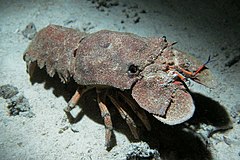Scyllarides latus
| Scyllarides latus | |
|---|---|

| |
| Scientific classification | |
| Domain: | Eukaryota |
| Kingdom: | Animalia |
| Phylum: | Arthropoda |
| Class: | Malacostraca |
| Order: | Decapoda |
| Suborder: | Pleocyemata |
| Family: | Scyllaridae |
| Genus: | Scyllarides |
| Species: | S. latus
|
| Binomial name | |
| Scyllarides latus | |
| Synonyms | |
| |
Scyllarides latus, the Mediterranean slipper lobster, is a
Distribution
Scyllarus latus is found along most of the coast of the Mediterranean Sea (one exception being the northern Adriatic Sea[3]), and in parts of the eastern Atlantic Ocean from near Lisbon in Portugal south to Senegal, including the islands of Madeira, the Azores, the Selvagens Islands and the Cape Verde Islands.[2] In Senegal, it occurs together with a related species Scyllarides herklotsii, which it closely resembles.[3]
Description
S. latus can grow to a total body length about 45 centimetres (18 in), although rarely more than 30 cm (12 in). This is equivalent to a carapace length of up to 12 cm (4.7 in).[2] An individual may weigh as much as 1.5 kilograms (3.3 lb).[3] As in all slipper lobsters, the second pair of antennae are enlarged and flattened into "shovels" or "flippers".[4] Despite the name "lobster", slipper lobsters such as Scyllarides latus have no claws, and nor do they have the protective spines of spiny lobsters. Instead, the exoskeleton, and particularly the carapace, are thicker than in clawed lobsters and spiny lobsters, acting as resilient armour.[3] Adults are cryptically coloured, and the carapace is covered in conspicuous, high tubercles.[2]
Ecology
Substrate
S. latus lives on rocky or sandy substrates at depths of 4–100 metres (13–328 ft).[2] They shelter during the day in natural dens, on the ceilings of caves, or in reefs, preferring situations with more than one entrance or exit.[3]
Diet
The diet of S. latus consists generally of
Predators

The most significant
Life cycle
Male Scyllarus latus carry
The larvae are much less well known than the adults. An initial 1.3 millimetres (0.05 in) long naupliosoma stage, which swims using its antennae, moults into the first of eleven phyllosoma stages, which swim using their thoracic legs.[6] The last phyllosoma stage may reach a size of 48 mm (1.9 in) and can be up to 11 months old; most of the intermediate phyllosoma stages have not been observed.[3] A single nisto (juvenile has been recorded, having been caught off Reggio Calabria in 1900, but only recognised as being a juvenile S. latus in 2009.[7] Young adults are also rare; a museum specimen with a carapace length of 34 mm (1.3 in) is the smallest adult yet observed. Adults moult annually, and probably migrate to cooler waters with a temperature of 13–18 °C (55–64 °F) to do so. The old exoskeleton softens over a period of 10–22 days before being shed, and the new, pale exoskeleton takes around three weeks to harden completely. Smaller individuals typically gain weight over the course of a moult, but this difference is less pronounced in larger animals.[3]
Behaviour
Scyllarides latus is mostly nocturnal in the wild, since most of its
Predator avoidance may also explain the frequent behaviour where S. latus will carry food items back to a shelter before consuming them. When two S. latus individuals compete for a food item, they may use the enlarged second antennae to flip their opponent over, by wedging the antennae underneath the opponent's body and quickly raising them. An alternative strategy is to grip an opponent and begin the tail-flipping movement, or to engage in a tug of war.[3]
Taxonomy
Scyllarides latus was originally classified in the genus
The only other species of Scyllarides to occur in the Eastern Atlantic is Scyllarides herklotsii, which differs from S. latus mostly in the ornamentation on the carapace; while in S. latus the tubercles (lumps projecting from the surface) are high and pronounced, they are lower and more rounded in S. herklotsii.[10]
Type specimen
The
Human consumption
S. latus is edible, but it is a relatively rare species, and is therefore of little interest to
References
- . Retrieved 19 November 2021.
- ^ ISBN 92-5-103027-8.
- ^ .
- S2CID 52232092.
- .
- ^ Gilbert Archey (1915). "Notes on the marine crayfish of New Zealand". Transactions and Proceedings of the Royal Society of New Zealand. 48: 396–406.
- .
- ^ Lipke B. Holthuis (2002). "The Indo-Pacific scyllarine lobsters (Crustacea, Decapoda, Scyllaridae)" (PDF). Zoosystema. 24 (3): 499–683.
- ISBN 92-5-103027-8.
- ISBN 92-5-103027-8.
- ^ a b Lipke B. Holthuis (1996). "Original watercolours donated by Cornelius Sittardus to Conrad Gesner, and published by Gesner in his (1558–1670) works on aquatic animals". Zoologische Mededelingen. 70 (11): 169–196.
External links
 Media related to Scyllarides latus at Wikimedia Commons
Media related to Scyllarides latus at Wikimedia Commons

